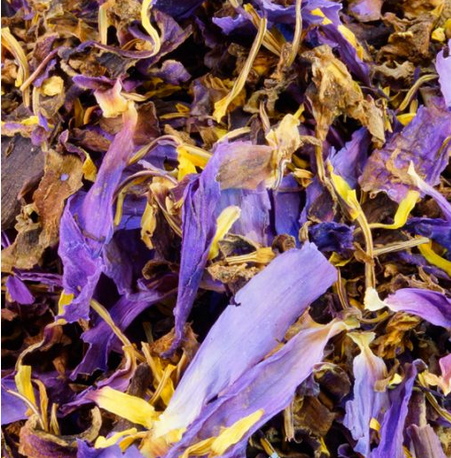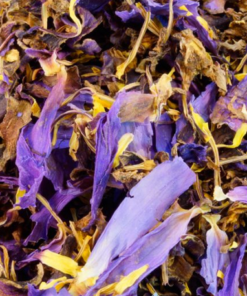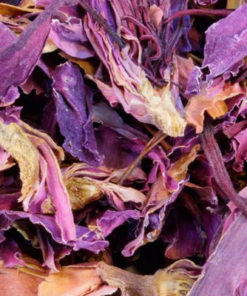BLUE LOTUS – BREATH OF GOD
$85.00
The aquatic Blue Lotus fresh water plant grows wild in ponds and has been prized for its beauty, seductive scent and its symbolism. As well as for its consciousness altering effects.
The aquatic Blue Lotus fresh water plant grows wild in ponds and has
been prized for its beauty, seductive scent and its symbolism. As well
as for its consciousness altering effects.
Native Use
Nymphaea caerulea is a revered plant that was used during
rituals in ancient Egypt. When Pharaoh Tutankhamen’s tomb was opened,
they discovered that Blue Lotus flowers had been scattered over his
body. Initially, it was thought that these flowers were purely symbolic.
However there is a growing body of research that is pointing towards
the Egyptians using Nymphaea caerulea to induce ecstatic states,
euphoria, feelings of wellbeing and visions. The Blue Lotus has also
been found in representations of Egyptian art and hieroglyphics in
relation to afterlife and rebirth. Women would wear the buds in their
hair as adornments.
Traditionally, the flower extracts were taken as drops. The flowers
can also be made into tea or soaked in wine. Smoking the dried flowers
was also common practice.
Some evidence suggests that Nymphaea caerulea was used to
relieve pain, increase memory and to improve circulation. It is said
that the Egyptians used it to enhance sexual desire, and that it was
viewed as an essential key to good health.
The flowers were used to treat liver ailments, constipation, neutralize poison and to regulate the urinary system. Nymphaea caerulea
contains the chemical constituent apomorphine, which acts as a dopamine
antagonist, as well as nuciferine, nupharine and nupharidine. The
flowers also contain other alkaloids such as kaempferol, which act as a
type of MAOI.
Habitat
Historically, Blue Lotus was found growing in the lowlands of the
Nile. The sky blue and sometimes purple flowers bloom during the day.
They are star-shaped with upright pointed petals that grow atop a long
stem, sometimes 4-5 feet above the water. Its leaves are round and flat,
which sit atop the water’s surface. The plant used to grow only in the
wetlands of the Nile delta, with some found in Palestine. However, blue
lotus now has disappeared almost completely from the Nile region and is
seriously endangered.
Scientific information
The blue lotus flower (Nymphea caerulea) is an Egyptian water lily
containing apomorphine and nuciferine. The apomorphine is a widely used
agent for parkinson’s disease in it’s isolated form. Nuciferine is an
alkaloid associated with dopamine receptor blockade.
READ MORE
Be the first to review “BLUE LOTUS – BREATH OF GOD” Cancel reply
Shipping Policy
This Shipping Policy applies to all purchases made through The Malachian Empire and its affiliated companies or stores within its marketplace (collectively referred to as "the Marketplace"). By placing an order, you agree to the terms and conditions outlined in this policy.
- Shipping Carriers and Services: The Marketplace utilizes various shipping carriers and services to deliver orders, depending on the destination, size, and weight of the package. These carriers may include, but are not limited to, UPS, FedEx, DHL, and USPS. The specific carrier and service will be selected at the sole discretion of the Marketplace, unless otherwise specified or requested by the customer at the time of order.
- Shipping Rates: Shipping rates are calculated based on the destination, size, and weight of the package, as well as the selected shipping service. Rates will be displayed during the checkout process, prior to finalizing the order. The Marketplace reserves the right to adjust shipping rates at any time without prior notice.
- Shipping Timeframes: The Marketplace aims to process and ship orders within a reasonable timeframe, typically within 1-3 business days after the order is placed. However, processing times may vary depending on the availability of items and the volume of orders. Once shipped, the delivery time will depend on the shipping service selected and the destination. The Marketplace is not responsible for any delays caused by the shipping carrier or other factors beyond its control.
- Order Tracking: Once your order has been shipped, you will receive a shipping confirmation email with tracking information. You may also access the tracking information by logging into your account on the Marketplace's website.
- International Shipping: The Marketplace ships to select international destinations. International orders may be subject to customs duties, taxes, and fees imposed by the destination country, which are the responsibility of the customer. The Marketplace is not responsible for any delays due to customs clearance or other factors beyond its control.
- Shipping Address Accuracy: It is the customer's responsibility to provide accurate and complete shipping information at the time of order. The Marketplace is not responsible for any delays or additional costs resulting from incorrect or incomplete shipping addresses. If a package is returned to the Marketplace due to an incorrect or undeliverable address, the customer will be responsible for the cost of reshipping the item.
- Damaged or Lost Packages: If your package arrives damaged, please contact the Marketplace's customer service team within 48 hours of delivery. The Marketplace will work with the shipping carrier to investigate the issue and, if necessary, arrange for a replacement or refund. If your package is lost or not delivered within the expected timeframe, please contact the Marketplace's customer service team for assistance. The Marketplace is not responsible for packages that are confirmed as delivered by the shipping carrier but are not received by the customer.
By placing an order with The Malachian Empire or any affiliated companies or stores within its marketplace, you agree to the terms and conditions outlined in this Shipping Policy.
Refund Policy
At Malachian Empire, we strive to provide our customers with high-quality products and services. We understand that sometimes, despite our best efforts, customers may need to return or exchange a product or service. To ensure a smooth and hassle-free return process, we have established the following refund policy:
We offer cash refunds for products and services purchased through Malachian Empire within 7 days of purchase. However, after 7 days, we do not offer cash refunds. Instead, we provide store credit for all products and services returned within 30 days of purchase.
Please note that we strongly encourage our customers to make sure that they fully understand the product or service they are acquiring before making payment. It is important to carefully read the product description, review product images, and check product specifications to ensure that it meets your needs.
If you are unsure about a product or service, please do not hesitate to contact our customer service team. Our team is available to answer your questions, provide product recommendations, and assist you in making an informed decision before making a purchase.
In the event that you need to return or exchange a product or service, please contact our customer service team within the specified timeframe. We require that all returned products and services are in their original condition and packaging, with all accompanying materials and documentation. Any products or services that have been used or damaged may not be eligible for a refund or store credit.
We appreciate your business and your trust in Malachian Empire. If you have any questions or concerns about our refund policy, please do not hesitate to contact us.
Cancellation / Return / Exchange Policy
At Malachian Empire, we strive to provide our customers with high-quality products and services. We understand that sometimes, despite our best efforts, customers may need to return or exchange a product or service. To ensure a smooth and hassle-free return process, we have established the following refund policy:
We offer cash refunds for products and services purchased through Malachian Empire within 7 days of purchase. However, after 7 days, we do not offer cash refunds. Instead, we provide store credit for all products and services returned within 30 days of purchase.
Please note that we strongly encourage our customers to make sure that they fully understand the product or service they are acquiring before making payment. It is important to carefully read the product description, review product images, and check product specifications to ensure that it meets your needs.
If you are unsure about a product or service, please do not hesitate to contact our customer service team. Our team is available to answer your questions, provide product recommendations, and assist you in making an informed decision before making a purchase.
In the event that you need to return or exchange a product or service, please contact our customer service team within the specified timeframe. We require that all returned products and services are in their original condition and packaging, with all accompanying materials and documentation. Any products or services that have been used or damaged may not be eligible for a refund or store credit.
We appreciate your business and your trust in Malachian Empire. If you have any questions or concerns about our refund policy, please do not hesitate to contact us.
General Inquiries
There are no inquiries yet.











Reviews
There are no reviews yet.